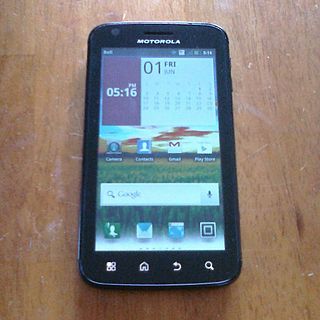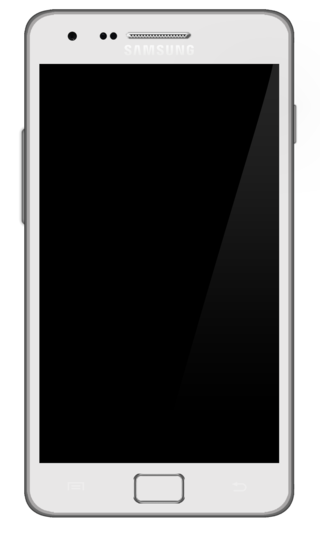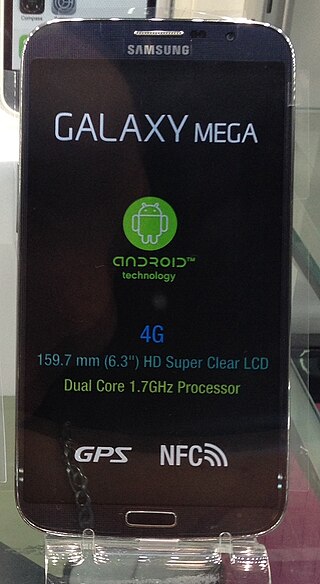
Snapdragon is a suite of system-on-a-chip (SoC) semiconductor products for mobile devices designed and marketed by Qualcomm Technologies Inc. The Snapdragon's central processing unit (CPU) uses the ARM architecture. As such, Qualcomm often refers to the Snapdragon as a "mobile platform". Snapdragon semiconductors are embedded in devices of various systems, including vehicles, Android, Windows Phone and netbooks. In addition to the processors, the Snapdragon line includes modems, Wi-Fi chips and mobile charging products.

The HTC Evo 4G is a smartphone developed by HTC Corporation and marketed as Sprint's flagship Android smartphone, running on its WiMAX network. The smartphone was launched on June 4, 2010. It was the first 4G enabled smartphone released in the United States.
Google Nexus is a discontinued line of consumer electronic devices that run the Android operating system. Google managed the design, development, marketing, and support of these devices, but some development and all manufacturing were carried out by partnering with original equipment manufacturers (OEMs). Alongside the main smartphone products, the line also included tablet computers and streaming media players; the Nexus started out in January 2010 and reached its end in October 2016, replaced by Google Pixel.

The Motorola Atrix 4G is an Android-based smartphone developed by Motorola, introduced at CES 2011 along with the Motorola Xoom, Motorola Droid Bionic, and Motorola Cliq 2 on January 5, 2011. It was made available in the first quarter of 2011.

The Samsung Galaxy S II is a touchscreen-enabled, slate-format Android smartphone designed, developed, and marketed by Samsung Electronics, as the second smartphone of the Samsung Galaxy S series. It has additional software features, expanded hardware, and a redesigned physique compared to its predecessor, the Samsung Galaxy S. The S II was launched with Android 2.3.4 "Gingerbread", with updates to Android 4.1.2 "Jelly Bean".

The HTC Evo 3D is a 3D-enabled Android smartphone developed by HTC, released exclusively in the United States through Sprint, and was re-released as a pre-paid smartphone by Virgin Mobile in May 2012 as the HTC Evo V 4G. A variation of Sprint's flagship HTC Evo 4G, the device is distinguished by its pair of 5 MP rear cameras, which made the Evo 3D the first cell phone to do so, which can be used to take photos or video in stereographic 3D, which can be viewed on its autostereoscopic display without the need for 3D glasses. Several GSM variants are also available in Canada, Europe and Asia.

The HTC One S is a premium smartphone designed and manufactured by HTC as part of the HTC One series which has Beats Audio and runs the Android 4.0 "Ice Cream Sandwich" mobile operating system with HTC Sense. Announced by HTC on 26 February 2012, the HTC One S was scheduled for official release on 2 April 2012. The first phones were sold on March 30. In the United States, the One S is carried by T-Mobile and Solavei.

The HTC Evo 4G LTE is an Android smartphone developed by HTC Corporation to be released exclusively by Sprint. A successor to the previous HTC Evo 4G and 3D models, the Evo 4G LTE supports Sprint's LTE cellular network and its current-generation EV-DO network. The Evo 4G LTE shares features with its GSM counterpart, the HTC One X—such as the same dual-core 1.5 GHz processor used by the One X's LTE variant, a 4.7-inch screen, and Android 4.1 with HTC's Sense 4.0 interface. The Evo 4G LTE was also the first phone built with an all aluminum frame, leaving only a small plastic piece to allow the Sim and micro sd cards to be installed.
HTC One is a series of Android and Windows Phone smartphones designed and manufactured by HTC. All products in the One series were designed to be touchscreen-based and slate-sized, and to initially run the Android mobile operating system with the HTC Sense graphical user interface. The one exception to this is the HTC One (M8), which also had a Windows Phone variant. From 2010 to 2013, all HTC products starting from the HTC Sensation XE to the HTC One Mini were equipped with a Beats Audio equalizer. Later HTC devices beginning with the HTC One Max no longer ship with Beats Audio following the buyback of HTC's stake in Beats Electronics.
The Droid Incredible 4G LTE, also known as the HTC Incredible 4G or Incredible 3, is a smartphone designed and manufactured by Taiwan's HTC Corporation that runs the Android 4.0 operating system (ICS). Officially announced by Verizon on May 7, 2012, for CTIA, and released on July 5, 2012, through Verizon Wireless for $149.99 with a new two-year contract. The Droid Incredible 4G LTE is the successor to the HTC Incredible S.
HTC EVO 4G+ is an Android smartphone developed by HTC Corporation, released exclusively in South Korea through Korea Telecom in 2011.A variation of HTC Evo 3D, the device is distinguished by its single 8 MP rear camera, which means all the 3D specificities are gone, and is running on Korea Telecom's WiBro network.

The Samsung Galaxy S III Mini is a touchscreen-based, slate-sized smartphone designed and manufactured by Samsung. It was announced in October 2012 and released in November 2012. The Galaxy S III Mini technological specifications include a 4-inch Super AMOLED display, a dual-core processor running at 1 GHz with 1 GB of RAM, a 5-megapixel rear camera, and a front-facing VGA camera for video calls or selfies.

The Samsung Galaxy S4 is an Android smartphone produced by Samsung Electronics as the fourth smartphone of the Samsung Galaxy S series and was first shown publicly on March 14, 2013, at Samsung Mobile Unpacked in New York City. It is the successor to the Galaxy S III, which maintains a similar design, but with upgraded hardware, more sensors, and an increased focus on software features that take advantage of its hardware capabilities—such as the ability to detect when a finger is hovered over the screen, and expanded eye tracking functionality, it was released the previous year. A hardware variant of the S4 became the first smartphone to support the emerging LTE Advanced mobile network standard. The T-Mobile version of the Galaxy S4, named the model (SGH-M919), was released the same month. The phone's successor, the Samsung Galaxy S5, was released the next year.

The Samsung Galaxy Mega is an Android-based phablet that was manufactured and released by Samsung. It was announced on April 11, 2013. The original model featured a 6.3 in (160 mm) screen, though a revised version was released with a 5.8 in (150 mm) screen. It has a 1,280×720 screen, a dual-core 1.7 GHz processor and an 8-megapixel camera. The phone runs Android 4.2.2 "Jelly Bean" software, and internal storage is 8 or 16 GB.

The Samsung Galaxy S4 Mini is an Android smartphone developed by the Korean manufacturer Samsung Electronics. Announced on May 31, 2013 and released in July 2013, the S4 Mini is a mid-range model of its flagship Galaxy S4 smartphone and a successor to the Galaxy S III Mini. It has a similar hardware design and software features to its high-end counterpart.

The HTC Butterfly S is an Android smartphone designed and manufactured by HTC. It is exclusive to Asian countries and currently has not been officially released in North America or Europe. The Butterfly S was unveiled on 19 June 2013 for release in Asian markets by July 2013. It is the successor to the HTC Butterfly, and incorporates hardware and software features first introduced by the HTC One, but is distinguished from the One by a larger, 5-inch 1080p display, a larger 3200 mAh battery and a Snapdragon 600 quad-core processor clocked at 1.9 GHz. The Butterfly S has a shiny plastic unibody compared to the aluminum unibody of the One, and has three capacitive buttons instead of two. It lacks the optical image stabilization of the One and the waterproofing of the original Butterfly. It has 16 GB of internal storage and a microSD card slot for storage up to 64 GB. The international 901s variant sold in Asian countries such as Singapore and Hong Kong has support for 4G LTE. The original Taiwanese version (901e) does not have LTE support and is currently available unlocked or on a contract with various carriers (initially only Chunghwa Telecom. An LTE version for Taiwan was announced in January 2014, following the implementation of LTE by various Taiwanese carriers. In China, two variants were released, a regular version with a 3200 mAh battery and a dual SIM version with a 2300 mAh battery. Only the Taiwanese variants officially received Android 5.0.2 Lollipop.
The HTC Desire 601 is an Android smartphone designed and manufactured by HTC. The Desire 601 is a mid-range device carrying design traits from the HTC One and One Mini, utilizing a dual-core processor, 4.5-inch qHD display, and offering LTE support.

The HTC Desire 610 is an Android-based smartphone designed and manufactured by HTC. It is an affordable smartphone part of the Desire range of mid-range handsets, and was aimed at the same market sector with devices such as the Motorola Moto G, Sony Xperia M2 and Nokia Lumia 735. It was announced on 24 February 2014 at Mobile World Congress 2014 in Barcelona, Spain. It was released in China in March 2014, in Europe starting April 2014 and in Australia on 5 August 2014.
The HTC Desire 620 is an Android-based smartphone designed and manufactured by HTC. It is part of the Desire range of mid-range handsets. It was announced on 29 November 2014 in Taiwan. It was announced for the European market on 9 December 2014.














